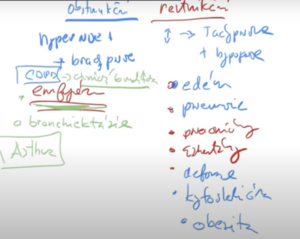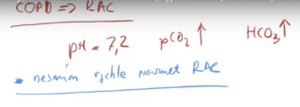Obstructive and restrictive lung diseases
|
This article was marked by its author as Under construction, but the last edit is older than 30 days. If you want to edit this page, please try to contact its author first (you fill find him in the history). Watch the discussion as well. If the author will not continue in work, remove the template Last update: Monday, 02 Oct 2023 at 8.32 pm. |
In ENGLISH (upper part of the page) and CZECH (lower part of the page)
Obstructive vs. restrictive lung diseases in ENGLISH - short
Intrapulmonary restrictive diseases (lung edema, pneumonia, ILD):
Extrapulmonary restrictive diseases (kyphoscoliosis, ALS, M. gravis):
EXTENDED HANDOUT by Nika Gavlasová & Coiled:
Restrictive diseases:
• Pathophysiological substrate = disorders of lung elasticity (the lungs are stiffer, lungs do not expand as well as normally) and reduction of a healthy parenchyma
• Compensation = hypopnea + tachypnea
• Examples:
• Pulmonary edema
• Pneumonia
• Intrapulmonary causes: Interstitial lung processes - Idiopathic pulmonary fibrosis, sarcoidosis, SLE, pneumoconiosis (asbestosis, silicosis)
• Extrapulmonary causes:
• Kyphoscoliosis - the most common cause of restrictive lung disease in elderly
• Obesity
• Neurological diseases: myasthenia gravis, Guillain-Barré syndrome, amyotrophic lateral sclerosis
Obstructive diseases:
• Pathophysiological substrate = narrowed airways, which means that both inhaling and, above all, exhaling is prolonged
• Compensation = HYPERPNOE + BRADYPNOE
• Representatives:
∆ COPD = chronic obstructive pulmonary disease
• The disease is primarily non-inflammatory! (inflammation worsens the obstruction)
• irreversible = irreversible lung disease, but in many cases preventable (do not smoke, alpha-1-antitrypsin substitution)
• COPD includes † chronic bronchititis, † emphysema and † bronchiectasis
† Chronic bronchitis
• If the patient coughs for at least 3 months 2 years in a row.
›Clinical type:
• Blue bloater - bronchial form (Type B), productive cough is quite characteristic (but the production is much smaller than in bronchiectasis), patients have swelling, are usually obese, V/Q mismatch is present » alveolar hypoxia » hypoxemia » polyglobulia + hypoxemia » cyanosis; alveolar hypoxia » pulmonary vasoconstriction » pulmonary hypertension » cor pulmonale » right heart failure » peripheral edema
† Emphysema
• Causes = excessive activation of proteases and other enzymes
• It is mainly an obstructive disorder, crucial is the change in the shape of the alveolus and loosening of the supporting scaffold apparatus by enzymes and inflammatory agents (elastin and collagen are degraded) - bronchi collapse, increased resitance
• Smoking
• α1-antitrypsin deficiency
›Clinical type:
• Pink puffer - emphysematous form (type A), exhales through a narrowed mouth (auto PEEP) » increase in residual volume » have an emphysematous = barrel-shaped chest, otherwise asthenic (cachectic), despite the marked shortness of breath, they are pink; cough is rather mild
† bronchiectasis
• the characteristic is a cough with extreme sputum production, patients are continuously on a prophylactic dose of ATB (pseudomonas!)
• local type › local infection
• diffuse type › systemic diseases - increased mucus viscosity (cystic fibrosis) or impaired ciliary motility (primary ciliary dyskinesia = Cartagena's syndrome)
∆ bronchial asthma
• With good pharmacological compensation, an asthmatic can blow a normal spirometric curve, i.e. the obstruction is temporary, not permanent, as in COPD.
• In contrast, acute attacks of asthma have major decreases of FEV1, asthma is primarily inflammatory disease
Case report
Patient, COPD, 60+ years old pH = 7.2 pCO2 increased HCO3- increased Long-term respiratory acidosis must not be corrected quickly! Why? Because of potassium. Explanation: In respiratory acidosis that lasts for some time (a chronic disease such as COPD), H+ enters cells in exchange for K+ » hyperkalemia. The kidneys react to it and potassium is excreted into the urine, then a "new" normokalemia is determined as part of pH changes (in our case RAC). If we would at this point correct this acidosis too quickly, massive influx of potassium into the cells could cause fatal hypokalemia; therefore with long-lasting acidosis always correct the acidosis very slowly.
Obstuctive vs. restrictive lung diseases in CZECH - short version
Obstructive vs. restrictive lung diseases in CZECH - detailed
EXTENDED HANDOUT by Nika Gavlasová & Coiled:
Restrikční choroby: 4:14
• Patfyz podklad = porucha elasticity plic (jsou tužší, nerozpínají se tak dobře jako zdravé) a redukce zdravého parenchymu
• Kompenzace = hypopnoe + tachypnoe
• Příklady:
• Edém plic
• Pneumonie
• Intrapulmonární příčiny: Intersticiální plicní procesy - Idiopatická plicní fibróza, sarkoidóza, SLE, pneumokoniózy (azbestóza, silikóza)
• Extrapulmonální příčiny:
• Kyfoskolióza - nejčastější příčina restrikčního plicního onemocnění ve stáří
• Obezita
• Neurologická onemocnění: myasthenia gravis, Guillainův–Barrého syndrom, amyotrofická laterální skleróza
Obstrukční choroby:
• Patfyz podklad = zúžené dýchací cesty, což znamená, že je zvýšený jak nádech, tak především výdech
• Kompenzace = HYPERPNOE + BRADYPNOE
• Zástupci:
∆ CHOPN = chronická obstrukční plicní nemoc
• onemocnění primáně nezánětlivé! (zánět až zhorší stav)
• nevratné = ireverzibilní plicní onemocnění, ale v mnoha případech preventabilní (nekouřit, substituovat alfa-1-antitrypsin)
• pod CHOPN řadíme †chronickou bronchitídu, †emfyzém a †bronchiektázie
† Chronická bronchitida
• Pokud pacient kašle minimálně 3 měsíce 2 roky po sobě.
›Klinický typ:
• Blue bloater - bronchiální forma (Typ B), produktivní kašel je zcela charakteristický (produkce je ovšem mnohem menší, než u bronchiektázie), pacienti mají otoky, zpravidla jsou obézní, je přítomen V/Q mismatch » alveolární hypoxie » hypoxémie » polyglobulie + hypoxémie » cyanóza; alveolární hypoxie » plicní vazokonstrikce » plicní hypertenze » cor pulmonale » selhání pravého srdce » periferní otoky
† Emfyzém 9:45
• Příčiny = nadměrná aktivace proteáz a dalších enzymů
• Jedná se zejména o obstrukční poruchu, podkladem je změna tvaru alveolu a rozvolnění závěsného aparátu enzymy a zánětlivými působky (rozkládají elastin a kolagen) - bronchy kolabují, zvětšení rezidu
• Kouření
• Deficit α1-antitrypsinu
›Klinický typ:
• Pink puffer - emfyzematická forma (Typ A), vydechují přes přivřená ústa (auto PEEP) » zvětšení reziduálního objemu » mají emfyzematický = soudkovitý hrudník, jinak asteničtí (kachektičtí), přes výraznou dušnost jsou ale růžoví, kašel minimálně
† bronchiektázie
• charakteristický je kašel s extrémní produkcí sputa, pacienti jsou kontinuálně na profylaktické dávce ATB (pseudomonáda!)
• lokální typ › lokální infekce
• difuzní typ › systémová onemocnění - zvýšená viskozita hlenu (cystická fibróza) či zhoršená motilita řasinek (primární ciliární dyskineze = Kartagenův syndrom)
∆ Astma bronchiale 11:01
• Astmatik dokáže při dobrém farmakologickém zajistění nadýchat normální spirometrickou křivku, čili obstrukce je dočasná, ne permanentní, jako je tomu u CHOPN.
• Oproti tomu akutní záchvat astmatu - dochází ke snížení FEV1, onemocnění je primárně zánětlivé
Kazuistika 13:55
Pacientka, CHOPN, 60+ let pH = 7,2 pCO2 zvýšené HCO3- zvýšené Dlouhodobě trvající respirační acidóza se nesmí rychle korigovat! Proč? Kvůli kalémii. Vysvětlení: Při respirační acidóze, která trvá delší dobu (chronické onemocnění jako CHOPN) se H+ dostává do buněk výměnou za K+ » Hyperkalémie. Na ni reagují ledviny a dochází k vyloučení nadměrného kalia do moči, čímž se ustanoví "nová" normokalémie v rámci změny pH (v našem případě RAC). Pokud bychom tuto acidózu korigovali rychle, mohlo by dojít k masivnímu influxu draslíku do buněk a závažné hypokalémii. Proto při chronických změnách pH vždy korigujeme pH velice pomalu.




